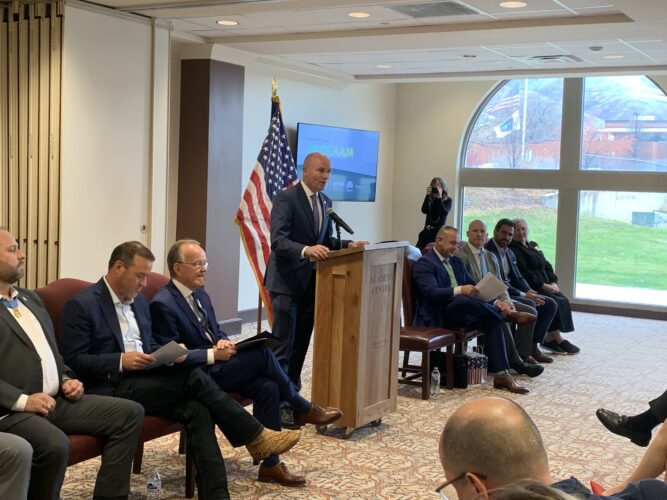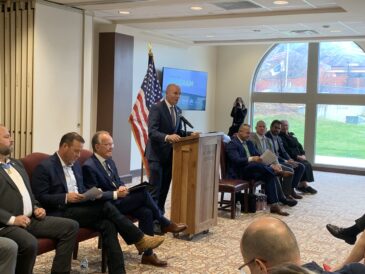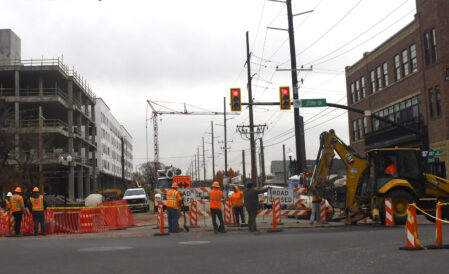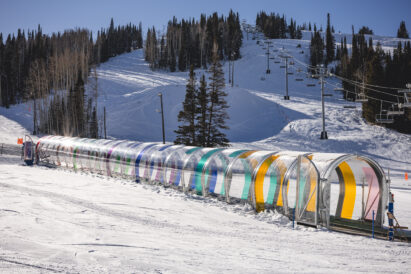Announcement places Brigham City, Northern Utah at the center of ‘nuclear energy ecosystem’

Rob Nielsen, Standard-Examiner
Utah Gov. Spencer Cox announces a deal to form a Northern Utah "nuclear energy ecosystem" in Brigham City on Monday, Nov. 17, 2025.BRIGHAM CITY — Northern Utah is poised to be critical in the future of nuclear power in the state and beyond.
On Monday, state and industry officials gathered at the Brigham Academy Center to announce a partnership between Hi Tech Solutions and Holtec International that would make the city the center of a “nuclear energy ecosystem” involved in training operators and workforce, the manufacture of small modular reactors, or SMRs, and potentially even hosting power-generating SMRs in Box Elder County in the future.
“Strategically located in Northern Utah’s defense and aerospace corridor, the proposed Brigham City-based project will boast the deployment of advanced nuclear technologies like Holtec’s SMR-300 small modular reactor, create educational and workforce pipelines, and bring a range of manufacturing jobs to rural Utah,” a press release on Monday’s event stated. “The project would establish the state’s first full-scale nuclear energy ecosystem by uniting advanced manufacturing, reactor deployment, and workforce development.”
Following the announcement on Monday, Brigham City Mayor DJ Bott told the Standard-Examiner that the city is moving forward with being a center for nuclear workforce development and SMR manufacturing.
“We announced a workforce training program that’s going to be established in Brigham City — that’s Hi Tech Solutions,” he said. “Then the MOU between Hi Tech and Holtech will bring manufacturing to Northern Utah that will actually manufacture the small modular reactors in the future.”
He said the workforce element will naturally be the quickest to get started while manufacturing and any potential use of SMRs in the area is years away.
“Hi Tech should be working on a temporary facility here inside Brigham City within the next nine months to a year,” he said. “The actual generation is going to depend on the licensing process and the due diligence for the ground that’s been identified as to whether it’s suitable for nuclear. Preliminarily, they think it is.”
Bott said permitting could take upwards of seven years.
Executive Director of the Utah Department of Natural Resources Joel Ferry told the Standard-Examiner that SMRs differentiate themselves from the reactors that have been the standard of commercial nuclear power for decades.
“There’s 96 active nuclear reactors in the United States,” he said. “Those are what are known as light-water reactors. That’s the old technology. They need a ton of water. The safety on them is still really solid, but the advancements that we’ve made in eliminating some of the risks make SMRs extremely stable. Essentially zero risk of any meltdown, zero risk of any sort of seismic activity interfering with the way they function. And ultimately, the way that they’re deployed … can be done without huge footprints or having huge environmental impacts.”
He said they also consume considerably less water and can be safely deployed in much smaller buildings while being more efficient.
“These new technologies are fantastic and they really enhance the ability of a state like Utah to harness nuclear power and to use it to our benefit,” he said.
During the announcement, Utah Gov. Spencer Cox said this plan is a key part of the state’s Operation Gigawatt initiative.
“We have the resources to generate the power that we need and that those beyond the borders of our state need as well,” he said. ‘When we build the supply chains and workforce to meet those energy needs domestically and locally, we don’t just increase Utah’s energy security and independence, we increase our national security, which is more important than ever. … We know that our adversaries China and Russia are racing to dominate the next generation of nuclear technology, and they’re moving very rapidly. If America is going to remain secure and strong, we have to lead — not just in ideas — we have to lead in action.”
He added that Utah is ready to take the lead in this endeavor.
“This project’s manufacturing effort will unlock economies of scale that lower cost and make civil nuclear energy more affordable for communities across Utah and wherever this model is going to be adopted,” he said. “Utah’s commitment to taking bold action and building things locally is why we are quickly becoming a hub for next-generation nuclear work generating jobs, creating and strengthening the grid and positioning ourselves for leadership.”
Cox said that taking the lead on new nuclear energy development doesn’t mean sacrificing safety.
“And when we build, we do it safely and responsibly,” he said. “Safety remains the standard that we always build to. Today’s Gen-III and Gen-IV technologies meet the strictest safety and environmental standards anywhere in the world. They are regulated by federal and state agencies with multiple layers of protection, making civil nuclear power among the safest industrial operations anywhere.”
Bott said this is a big moment for the region.
“Everybody should be excited, I think,” he said. “The nation is going to be looking at us.”



